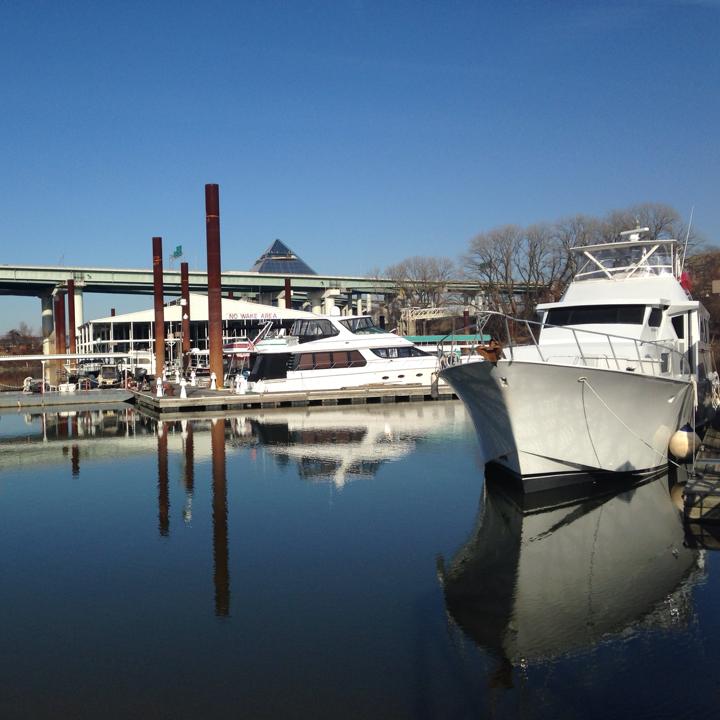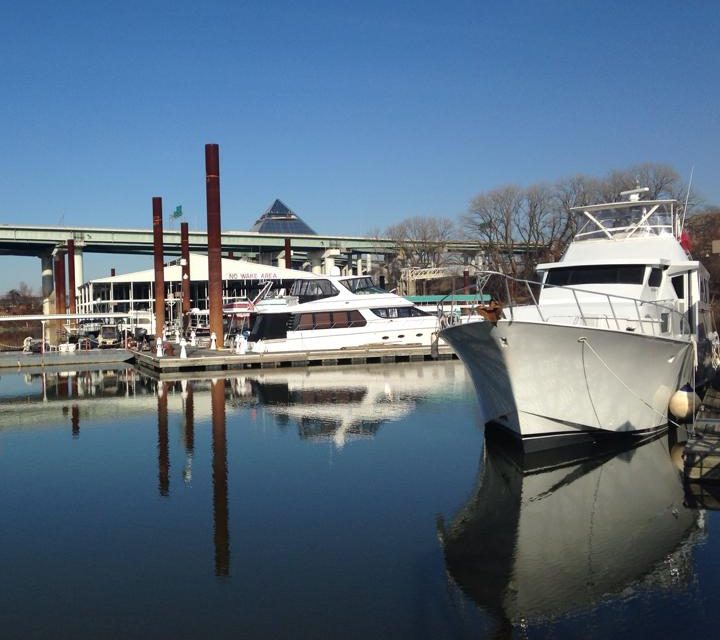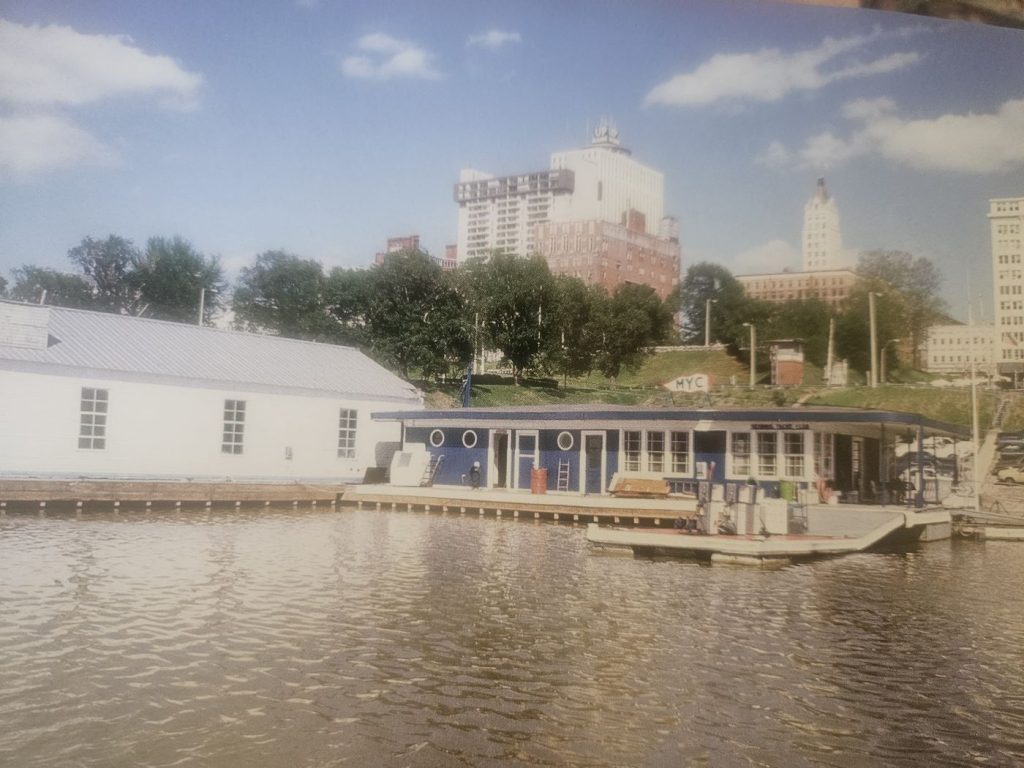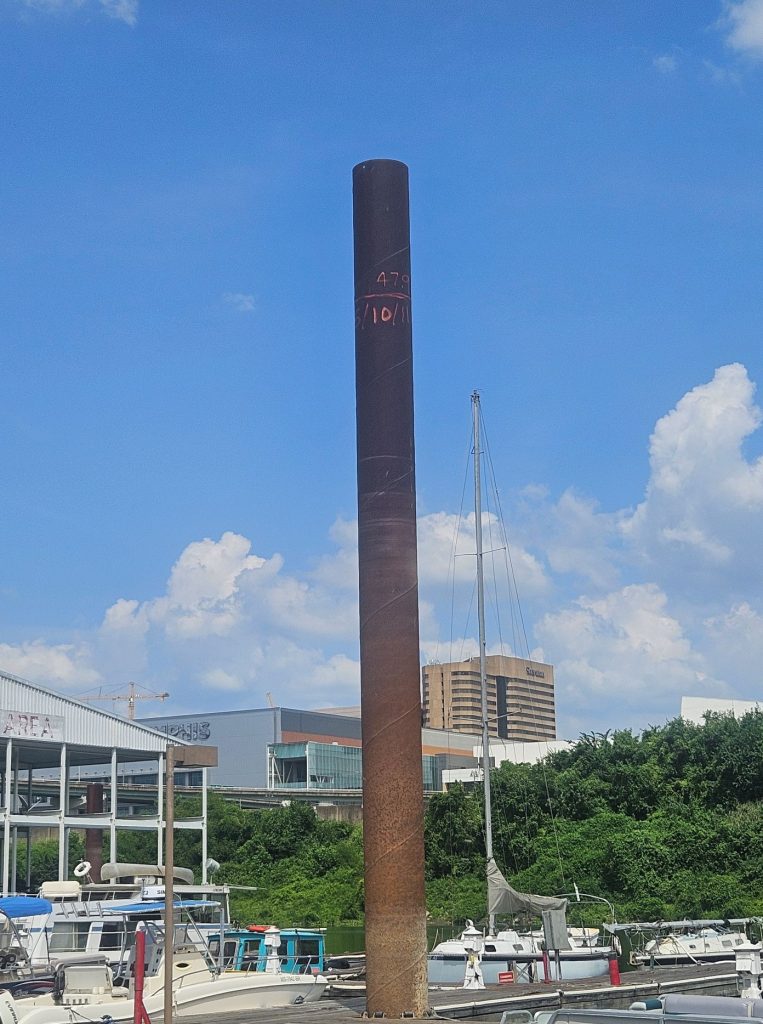Those of us of a very certain age can still remember the colorful floating boat houses located at the foot of the cobblestones.
 They were home to the Memphis Yacht Club for 75 years until it moved as part of the Mud Island project more than 40 years ago. City government convinced the Yacht Club to move away in 1980 from the cobblestones with the lure of a brand new marina at Mud Island on the Wolf River.
They were home to the Memphis Yacht Club for 75 years until it moved as part of the Mud Island project more than 40 years ago. City government convinced the Yacht Club to move away in 1980 from the cobblestones with the lure of a brand new marina at Mud Island on the Wolf River.
However, today, there are no more images of gleaming boats and stunning yachts to draw us to images of its new home between the Mud Island monorail and Hernando de Soto Bridge. The yachts and boats are obscured by an overgrowth of trees and towering weeds and plants.
It’s a sad condition for the historic Yacht Club which celebrates its 125th anniversary next year.
When Memphis Mayor A C Wharton Jr. was in office, he sent crews to clear the riverbanks on both sides of Wolf River so people could enjoy the appealing sight of the boats and yachts for their luxury, craftsmanship, and suggestion of adventure.
When that was done, it was possible to see the 88 slips there from City Hall. No more. Its present setting reeks of neglect, a lack of appreciation for the potential activation of Mud Island that could take place there, and the early uplifting promises for moving there.
Bait and Switch?
The administration of Mayor Paul Young and Memphis City Council regularly talk often about the problems caused by city government’s failure to adequately maintain city-owned property.
Mud Island Marina is a good case in point.
After all, the Yacht Club is a nonprofit organization operating on city-owned property. Attention from City of Memphis seems long overdue.
With a little imagination from city government, it might be possible for the club to help activate the northern end of Mud Island. However, these days, it proves the truth of the old adage, out of sight, out of mind.
Memphis Hospitality on the River
 “We want to be hospitable and the most active partner city government and Memphis River Parks Partnership have ever had,” Manager John Gary said. “We have the capability – with the city – to be the best partner in reactivating the marina. We’re the only active marine on the Lower Mississippi River which means we are the gas station between New Orleans and St. Louis. We want it to be a place we can all be proud of as we look forward to the future.”
“We want to be hospitable and the most active partner city government and Memphis River Parks Partnership have ever had,” Manager John Gary said. “We have the capability – with the city – to be the best partner in reactivating the marina. We’re the only active marine on the Lower Mississippi River which means we are the gas station between New Orleans and St. Louis. We want it to be a place we can all be proud of as we look forward to the future.”
Chairman of the Yacht Club board Keith W. Brown, who’s called commodore in that role, said the marina plays host to paddlers and kayakers along with snowbirds and always shows them Memphis hospitality. “We remind them that the Mississippi River is different from a still water lake or even rivers like the Tennessee River,” he said. “There’s a constant up and down with the four mile an hour current. It’s not like anything else.”
Mr. Gary adds: “As Joe Royer often said, the Mississippi River is our Himalayans.” Mr. Royer founded Outdoors Inc. and is known as an inveterate kayaker of the river. He said that while Memphians say the river is our greatest asset, we undervalue it.” His comment seems especially apropos looking at the maintenance needs of the marina.
It was the popularity of pleasure boating and the historic lure of the river that led to formation of the Memphis Boat Club. That was the first name of the Memphis Yacht Club and first mentioned in The Commercial Appeal’s River News on February 23, 1901. It reported that “the river men are now interested in the boating club. The contract for construction of the floating boathouse has been let and it will be one of the most complete ever launched on the Mississippi River.”
A Little History
Made of longleaf yellow pine – Memphis was the largest hardwood lumber market in the world at the time – the first boathouse was 110 feet long with a 24-foot hull and was built in the river at the foot of Court Street. The first story was to be occupied by a dance hall with rooms and lockers for members on the second floor. “The members are determined to make the club a success,” the newspaper reported.
In the first year after opening, the Club limited its membership to 150 and by early 1901, it had 142 members with eight vacancies and 175 applications. The initiation fee was $25 and semi-annual dues were $9.
In 1902, it organized a regatta of 10 events that included sailboat races and walking a greased spar. Talk about activation.
The Club opened in a decade of robust growth in Memphis as its population grew from 102,000 in 1900 to 131,000 in 1910. It was a time of heady ambitions by Memphis leadership as the city became a shining light of the Progressive Era only a couple of decades after the last yellow fever outbreak had reduced the population to 34,000.
A River City
A history of the Yacht Club points out that the river had special relevance in those early years of the 20th century because there was no automobile traffic across the river. That wasn’t made possible until the Harahan Bridge was completed in 1917. When the bridge burned in 1928, two Memphis businessmen funded a large boat and barge to ferry cars across the river while the bridge was being restored with a more fire-resistant roadway.
In 1948, the Yacht Club built a new boathouse, this one at the foot of Poplar across from Mud Island where club members were familiar with the families, squatters and hermits that farmed and fished for a living there.
The Club remained there until it moved to the present marina, but regardless of where it has been located over 125 years, the Yacht Club members have been firsthand witnesses to the relationship between Memphis and the river that led to its founding.
Stories about the river hover between mythology and reality but speak to how the culture and personality of Memphis have been defined by the river flowing by its front door. A rich chapter of that history features the Memphis Yacht Club.
**
Join us at the Smart City Memphis Facebook page and on Instagram for daily articles, reports, and commentaries that are relevant to Memphis.






